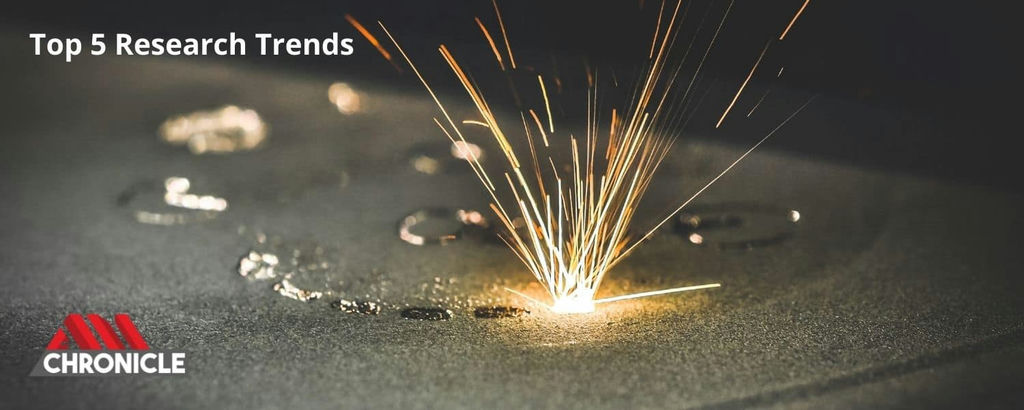
Metal additive manufacturing (AM) research is on the upward trends due to its wide use in the aerospace, automobile, space, and manufacturing sectors. Constantly, new research areas are developing in metal AM to improve the performance of the process. The article covers the recent trends of research in metal additive manufacturing.
Machine Learning in metal additive manufacturing
A complex thermodynamic equation governs the process associated with metal AM , and it is challenging to simulate this equation accurately using conventional computer programs. Guo et al. (2022) used the machine learning method to simulate the metal AM process. The researcher used a physics-informed machine learning model, a hybrid machine learning model, to predict the results.
The main advantage of using machine learning in metal AM is that, it helps to identify the defects in an effective manner, reach to new conclusions and learning and improve the quality of the final print. But, the limitation is the technology is yet under development and industrial application is missing.
Residue stress in metal additive parts
Due to thermal, mechanical, and metallurgical changes, residual stresses are developed in the metal additive parts. This residue stress affects the mechanical properties of the developed part, and an in-depth understanding of the residue stress is significant to develop parts for the aerospace or medical industry. Chen et al. (2022) discuss different mechanisms, parameters, and control strategies to reduce the residual stress of metal AM parts.
Hybrid Metal Additive Manufacturing
Hybrid metal AM combines subtractive additive manufacturing and metal AM in a single setup. The review developed by Pragana et al. (2022) helps to understand the different aspects of hybrid metal AM and the challenges and opportunities in the sector.
The main advantages of the hybrid metal AM is that, it reduces the need for finishing operation of metal AM parts, that is done through the CNC process. Additionally, complex parts such as impeller, turbine blades can be developed rapidly. It also reduces the cost as the cost of inventory of expensive materials decreases.
Simulation of metal additive manufacturing
Simulation is the process of predicting the properties of metal AM parts without any testing through a computer program. The simulation process is significant in cost reduction and saves the metal AM process time. Several researchers have proposed several models for the simulation process of metal AM , and each process has its advantage and limitation. In a study developed by Rodgers et al. (2017), researchers developed the kinetic Monte Carlo model to predict three-dimensional grain structure in additively manufactured metals. The previously proposed model was modified, and new factors were added to improve the results.
Source: https://www.nsrp.org/
Surface Treatment in Metal Additive Manufacturing
The surface treatment process in metal AM is performed to eliminate or reduce the defects in the metal AM part. Various surface treatment methods have been suggested in the literature, and knowledge of these methods is a must for anyone associated with the process. The surface imperfections and defect types are staircase effect, partially fused feedstock material, balling effects, spatter, or inadequate fusion lead to notably irregular surface morphology. The review paper developed by Maleki et al. (2021) provides detailed information about the reasons for surface defect occurrence and the methods used to remove them.
Disclaimer: The trends identified in this article are based upon the authors’ capability and developed without using any scientific method.
Sources:
Chen, S.G., Gao, H.J., Wu, Q., Gao, Z.H. and Zhou, X., 2022. Review on residual stresses in metal additive manufacturing: Formation mechanisms, parameter dependencies, prediction and control approaches. Journal of Materials Research and Technology.
Guo, S., Agarwal, M., Cooper, C., Tian, Q., Gao, R.X., Grace, W.G., and Guo, Y.B., 2022. Machine learning for metal additive manufacturing: Towards a physics-informed data-driven paradigm. Journal of Manufacturing Systems, 62, pp.145-163.
Maleki, E., Bagherifard, S., Bandini, M. and Guagliano, M., 2021. Surface post-treatments for metal additive manufacturing: Progress, challenges, and opportunities. Additive Manufacturing, 37, p.101619.
Pragana, J.P.M., Sampaio, R.F.V., Bragança, I.M.F., Silva, C.M.A. and Martins, P.A.F., 2021. Hybrid metal additive manufacturing: A state–of-the-art review. Advances in Industrial and Manufacturing Engineering, 2, p.100032.
Rodgers, T.M., Madison, J.D. and Tikare, V., 2017. Simulation of metal additive manufacturing microstructures using kinetic Monte Carlo. Computational Materials Science, 135, pp.78-89.
Subscribe to AM Chronicle Newsletter to stay connected: https://bit.ly/3fBZ1mP
Follow us on LinkedIn: https://bit.ly/3IjhrFq
Visit for more interesting content on additive manufacturing: https://amchronicle.com/
The U.S. Navy’s Maritime Industrial Base (MIB) Program, General Dynamics Electric Boat, and Lincoln Electric…
Caracol, a global leader in robotic large-format additive manufacturing, and RusselSmith, an ISO-certified provider of…
Works cited Additive Manufacturing Forecast 2025: Market - AMFG, accessed on June 28, 2025, https://amfg.ai/2025/02/12/additive-manufacturing-forecast-2025-market/…
National Additive Manufacturing and Innovation Company (NAMI), a joint venture between Dussur and 3D Systems…
The LEGO Group has announced the release of its first-ever mass-produced 3D printed component, which…
Boeing has unveiled a groundbreaking 3D-printed solar array substrate that promises to dramatically accelerate satellite…
This website uses cookies.